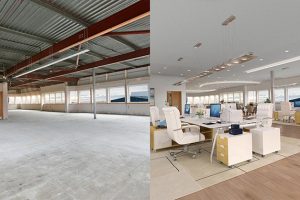 A commercial tenant improvement renovation is a cost-effective strategy to make your commercial space more attractive, functional, and relevant. By following proven strategies, you can successfully complete a tenant improvement renovation that will attract new clientele, optimize operations, and increase the value of your property. In this article, we will explore 10 strategies for a successful commercial tenant improvement renovation.
A commercial tenant improvement renovation is a cost-effective strategy to make your commercial space more attractive, functional, and relevant. By following proven strategies, you can successfully complete a tenant improvement renovation that will attract new clientele, optimize operations, and increase the value of your property. In this article, we will explore 10 strategies for a successful commercial tenant improvement renovation.
1. Start with a Well-Defined Budget
One of the first steps in planning a commercial tenant improvement renovation is to establish a clear and well-defined budget. Consult with your contractor to discuss your renovation plans and the associated expenses. Having a detailed budget will help you prioritize tasks and make informed decisions throughout the project. It is also advisable to include a contingency budget of at least 10% to cover unexpected expenses that may arise.
2. Emphasize Sustainability
Incorporating sustainable practices into your commercial tenant improvement renovation is not only environmentally friendly but also cost-effective in the long run. Consider using eco-friendly materials, such as recycled or low VOC products, and explore energy-efficient options like solar panels and LED lighting. By focusing on sustainability, you can reduce waste, lower utility costs, and create a healthier indoor environment for tenants and customers.
3. Plan and Schedule Carefully
Before starting the renovation, spend time finalizing all the details with your contractor. Clearly outline the scope of work, establish a timeline, and discuss any potential disruptions to daily operations. Planning and scheduling are crucial to ensure that the project progresses smoothly and on time. Regular communication with your contractor will help minimize work interruptions and ensure that everyone is on the same page.
4. Foster Team Collaboration
A successful tenant improvement renovation requires effective collaboration among all stakeholders involved. Encourage teamwork and open communication among the project team, including the contractor, architects, designers, and subcontractors. By fostering a collaborative environment, you can streamline decision-making, address challenges promptly, and ensure that all aspects of the renovation are executed efficiently.
5. Hire Qualified and Experienced Contractors
Choosing the right contractor for your commercial tenant improvement renovation is essential for project success. Look for contractors with a proven track record, relevant experience, and a portfolio of completed projects. It is crucial to find someone who understands your vision, communicates effectively, and can deliver high-quality work within the specified timeframe. Don’t hesitate to ask for references and testimonials to ensure that you are making the right choice.
6. Identify the Purpose of Renovation
Before embarking on a commercial tenant improvement renovation, clearly identify the purpose and objectives of the project. Determine the specific problems or challenges you are addressing and define the desired outcomes. Whether it’s to enhance functionality, create a more appealing space, or improve safety and compliance, having a clear purpose will guide the decision-making process and ensure that the renovation meets your goals.
7. Enhance Curb Appeal
While functionality and safety are key considerations, the aesthetic appeal of your commercial space should not be overlooked. Enhancing the curb appeal of your building can make a lasting impression on potential clients and customers. Consider landscaping, exterior signage, and architectural details that align with your brand and attract attention. Remember, first impressions matter, and a visually appealing exterior can make your business stand out from the competition.
8. Prepare for Temporary Workspaces
A commercial tenant improvement renovation can disrupt normal business operations. To minimize the impact on your tenants or your own business, make arrangements for temporary workspaces during the renovation. This could involve renting nearby office space or setting up temporary workstations within the building. By planning ahead and providing alternative workspaces, you can maintain productivity and minimize downtime.
9. Ensure Compliance with Permits and Regulations
Before starting any renovation work, it is essential to obtain the necessary permits and comply with local building codes and regulations. Work closely with your contractor to navigate the permit process and ensure that all necessary approvals are obtained. Failure to comply with regulations can result in delays, fines, or even legal issues. By taking care of permits early on, you can avoid potential setbacks and ensure a smooth renovation process.
10. Focus on Long-Term Investment
When planning a commercial tenant improvement renovation, consider the long-term benefits and return on investment. While it may be tempting to cut corners and opt for cheaper materials or shortcuts, investing in quality and durability will pay off in the long run. Think about the future use of the space, potential tenant preferences, and evolving market trends. Striking a balance between immediate needs and long-term investment will help maximize the value of your renovation.
We Provide Tenant Improvement Services
We renovate or remodel commercial spaces to meet the specific needs of a tenant. These services are essential for tenants who want to customize their leased space to fit their business requirements. Tenant improvement construction services can range from minor cosmetic upgrades to major structural changes.
> Learn More
A successful commercial tenant improvement renovation requires careful planning, collaboration, and a focus on sustainability. By establishing a clear budget, hiring qualified contractors, and prioritizing the needs of your tenants and customers, you can create a space that enhances your business’s functionality, appeal, and value. Follow these strategies, adapt them to your specific project needs, and watch your commercial space transform into a thriving environment for success.
Contact us (513-617-1401) for more information or a quote
—

About ABS Services
ABS Services provides comprehensive commercial construction services to Greater Cincinnati, Northern Kentucky, and Southeast Indiana. We have the experience, equipment, and the right team to get the job done!
> Learn More
